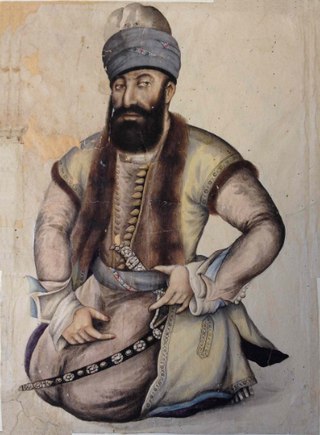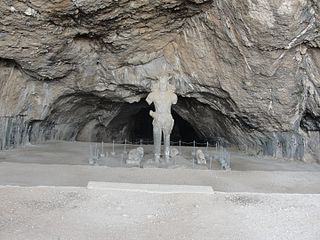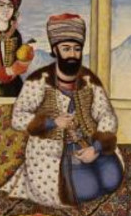
Agha Mohammad Khan Qajar, also known by his regnal name of Agha Mohammad Shah, was the founder of the Qajar dynasty of Iran, ruling from 1789 to 1797 as Shah. Originally a chieftain of the Quwanlu branch of the Qajar tribe, Agha Mohammad Khan was enthroned as the king of Iran in 1789, but was not officially crowned until March 1796, having deposed Lotf Ali Khan of the Zand dynasty in 1794.

Mohammad Karim Khan Zand was the founder of the Zand dynasty, ruling all of Iran (Persia) except for Khorasan from 1751 to 1779. He also ruled over some of the Caucasian lands and occupied Basra for some years.

The Zand dynasty was an Iranian dynasty, founded by Karim Khan Zand that initially ruled southern and central Iran in the 18th century. It later expanded to include much of the rest of contemporary Iran as well as parts of Iraq. The lands of present-day Armenia, Azerbaijan, and Georgia were controlled by khanates which were de jure part of the Zand realm, but the region was de facto autonomous. The island of Bahrain was also held for the Zands by the autonomous Al-Mazkur sheikhdom of Bushehr.

Kazerun is a city in the Central District of Kazerun County, Fars province, Iran, serving as capital of both the county and the district.
Protector, sometimes spelled protecter, is used as a title or part of various historical titles of heads of state and others in authority.
Abol-Fath Khan Zand was the third Shah of the Zand dynasty, ruling from March 6, 1779, until August 22, 1779.

Jafar Khan Zand, was the sixth shah (king) of the Zand dynasty of Iran from 1785 to 1789. He was the son of Sadiq Khan Zand, who was removed from the throne in Shiraz by Ali Murad Khan, who had previously taken Isfahan for himself.

Sadeq Khan Zand, also known as Mohammad Sadeq, was the fourth Shah of the Zand dynasty of Iran from August 22, 1779 until March 14, 1781.

Ali-Morad Khan Zand was fifth ruler of the Zand dynasty of Iran, ruling from March 15, 1781, until February 11, 1785.
Fath-Ali Khan Afshar, was a chieftain from the Afshar tribe of Urmia, and one of the four contenders for supremacy in Iran between 1751–1763. He was ultimately defeated and captured in February 1763 by one of the contenders, the Zand ruler Karim Khan Zand. The latter had Fath-Ali Khan executed the following year, in July 1764.
Zaki Khan Zand was an Iranian military commander and contender for the throne. A member of the Zand dynasty of Iran, Zaki Khan, though he never became the ruler of Iran, managed to exert power over the country during the three months between the death of his half-brother Karim Khan, on March 2, 1779, and his own brutal death.

Hajji Ebrahim Shirazi, also known by his honorific title E'temad ol-Dowleh, was an Iranian statesman who served as the kalantar of the city of Shiraz during the late Zand era and later as the first grand vizier of Qajar Iran.

Lotf Ali Khan was the last Shah of the Zand dynasty. He ruled from 1789 to 1794.

The Tabriz Khanate was a Caucasian Khanate from 1757 to 1799, centered around Tabriz and led by members of the Turkified Kurdish Donboli tribe.
The Afshars of Urmia are a branch of the Afshar tribe centered in the Iranian city of Urmia. From 1624/25 to 1820/21, the governorship of Urmia was mainly in the hands of the Urmia Afshars. After that, only a few them served as its governor, the last one being Imam Quli Khan, who became governor in 1879/80.

Shaykh Ali Khan Zand was a Zand nobleman, who was a close associate and prominent lieutenant of his cousin Karim Khan Zand. However, he later clashed with the latter, who had him blinded. He afterwards lived the rest of his life as an honored representative of the court, until a civil war occurred after Karim Khan's death in 1779, where Shaykh Ali Khan was killed by his cousin, Zaki Khan Zand.

The siege of Kerman (1794) was the capture of the city of Kerman by the Qajar forces led by Agha Mohammad Khan Qajar against Zand forces led by Lotf Ali Khan which resulted in a decisive Qajar victory. After the siege, Tens of thousands were killed, blinded or taken into slavery and it took the city decades to recover.
Ali-Qoli Khan Qajar was a son of Mohammad Hasan Khan Qajar and half-brother of Agha Mohammad Khan Qajar, the founder of the Qajar dynasty of Iran. Unlike Agha Mohammad Khan's full brothers, Ali-Qoli Khan served loyally from the outset and supported, for around twenty years, Agha Mohammad Khan's conquest for control over all of Iran. Following Agha Mohammad Khan's assassination in 1797, he unsuccessfully tried to claim himself as his brother's rightful successor. Ali-Qoli Khan was eventually blinded and exiled by his nephew Baba Khan, who would ascend the Iranian throne as Fath-Ali Shah Qajar.
Abu'l-Hasan Mostawfi Ghaffari was an 18th-century Iranian painter and historian from the Ghaffari family of Kashan. Besides several European-style paintings, he is also known to be the author of the Golshan-e Morad, a book covering the history of the Zand dynasty.













